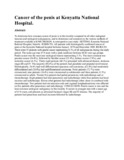Cancer of the penis at Kenyatta National Hospital.

View/
Date
2000-10Author
Magoha, G A
Ngumi, Z W
Type
ArticleLanguage
enMetadata
Show full item recordAbstract
OBJECTIVES:
To determine how common cancer of penis is in this locality compared to all other malignant tumours and urological malignancies, and to determine and comment on the various methods of treatment available at KNH.
DESIGN:
A retrospective case study.
SETTING:
Kenyatta National Referral Hospital, Nairobi.
SUBJECTS:
All patients with histologically confirmed cancer of penis at the Kenyatta National hospital between January 1970 and December 1999.
RESULTS:
There were 55 patients with penile cancer representing 0.1% of all malignancies during the study period. The mean age was 47.9 years with a peak incidence between 40-61 year age groups. Penile cancer was the most rare urological tumour representing 5.1%. The most common was prostate cancer (56.0%), followed by bladder cancer (25.0%), kidney cancer (7.9%), and testicular cancer (6.1%). Thirty eight patients (69.1%) presented with advanced disease, Jacksons stages III and IV. The majority (96.4%) of the patients had glandular and preputial involvement. Histologically, 56.4% had well differentiated squamous cell carcinoma, (23.6%) had moderately differentiated and (20.0%) had undifferentiated carcinoma. Forty patients (72.7%) were circumcised, nine patients (16.4%) were circumcised as adolescents and three patients (5.5%) circumcised as adults. Twenty five patients had partial penectomy with radiotherapy and or chemotherapy. Eight patients had total penectomy and radiotherapy while four patients had local excision and radiotherapy. Eleven other patients had radiotherapy either alone or combined with chemotherapy. Two patients had circumcision only and inguinal lymphadenectomy was effected on five patients after penectomy and radiotherapy.
CONCLUSION:
Penile cancer is rare and the least common urological malignancy in this locality. It occurs in younger men with a mean age of 47.9 years, and presents as advanced Jackson's stages III and IV disease. The majority of patients had penectomy and local excision followed by radiotherapy.
URI
http://erepository.uonbi.ac.ke:8080/xmlui/handle/123456789/10962http://www.ncbi.nlm.nih.gov/pubmed/12862118
Citation
East Afr Med J. 2000 Oct;77(10):526-30Publisher
Department of Surgery, College of Health Sciences, University of Nairobi
Collections
- Faculty of Health Sciences (FHS) [10415]
- Journal Articles [329]
